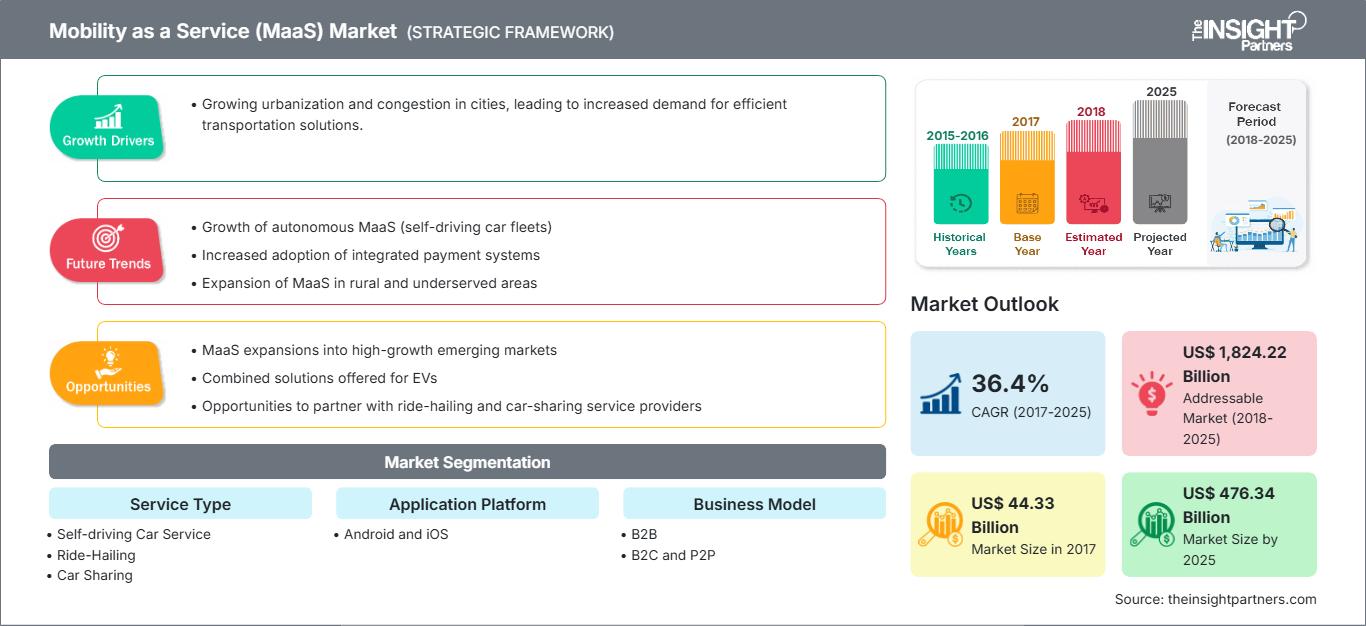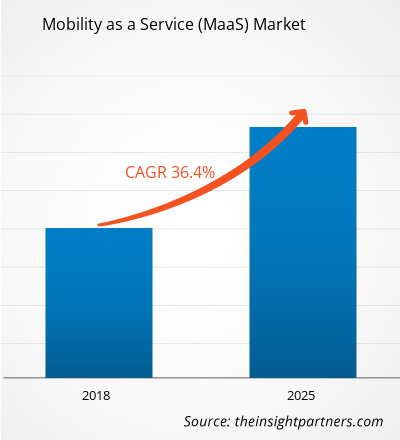2025年,出行即服务(MaaS)市场价值约为3987.9亿美元。预计到2034年,该市场将达到47211.5亿美元,2026年至2034年的复合年增长率(CAGR)约为31.6%。
出行即服务市场分析
出行即服务 (MaaS) 市场预测显示,在城市化进程加快、智慧城市建设以及对综合交通解决方案的需求推动下,市场将呈现强劲增长势头。据 The Insight Partners 的报告指出,多种出行服务(如网约车、汽车共享、公交共享、自行车共享)向统一平台的融合等因素,是推动市场扩张的关键所在。
数字技术(移动连接、GPS、数据分析)的进步进一步推动了这一增长,这些技术使得出行即服务(MaaS)平台能够无缝整合不同的交通方式。此外,交通生态系统中的公私合作以及政府的支持性法规也促进了MaaS解决方案在各地区的普及。
出行即服务市场概览
出行即服务 (MaaS) 是一种以用户为中心的交通出行理念,它允许客户通过单一的数字平台规划、预订和支付各种出行服务。该模式将出租车、汽车租赁、自行车共享、公共交通和公交共享等多种交通方式整合到一个服务产品中。
通过简化出行方式,出行即服务 (MaaS) 系统旨在减少对私家车的依赖,优化交通网络,并提升整体用户体验。它们支持行程规划、集成票务/支付以及服务提供商之间的实时协调。
根据您的需求定制此报告
您可以免费获得任何报告的定制服务,包括本报告的部分内容、国家/地区层面的分析、Excel 数据包,以及面向初创企业和高校的优惠折扣。
出行即服务 (MaaS) 市场:战略洞察

-
获取本报告的主要市场趋势。这份免费样品将包含数据分析,内容涵盖市场趋势、估算和预测等。
出行即服务市场驱动因素和机遇
市场驱动因素:
- 快速的城市化和智慧城市发展:城市正在投资智能交通系统和数字平台,以更有效地管理出行,这推动了对出行即服务 (MaaS) 的需求。
- 多元化出行服务的整合:从分散的交通方式向综合平台(网约车、汽车共享、公交共享)的转变正在推动增长。
- 技术进步与数字连接:移动应用、数据分析、GPS 跟踪和连接基础设施支持 MaaS 平台的交付和优化。
市场机遇:
- 新兴市场扩张:城市人口不断增长、出行需求日益增加的发展中地区为出行即服务 (MaaS) 解决方案提供了增长潜力。
- 订阅/平台商业模式:随着 MaaS 的发展,有机会采用和扩展按需付费、订阅移动套餐和集成服务生态系统等商业模式。
- 可持续性和出行电气化:减少车辆拥有量和降低排放的趋势为 MaaS 运营商整合电动/共享车队、可持续交通方式和多式联运服务开辟了道路。
出行即服务市场报告细分分析
按服务类型:
- 自动驾驶汽车服务
- 网约车
- 汽车共享
- 自行车共享
- 巴士共享
按应用平台划分:
- 安卓
- iOS
按商业模式:
- B2B(企业对企业)
- B2C(企业对消费者)
- P2P(点对点)
按车辆类型:
- 乘用车
- 自行车
- 公交车
按地理位置:
- 北美
- 欧洲
- 亚太地区
- 南美洲和中美洲
- 中东和非洲
出行即服务 (MaaS) 市场区域洞察
The Insight Partners 的分析师对预测期内影响出行即服务 (MaaS) 市场的区域趋势和因素进行了详尽的阐述。本节还探讨了北美、欧洲、亚太、中东和非洲以及南美和中美洲等地区的出行即服务 (MaaS) 市场细分和地域分布。
出行即服务 (MaaS) 市场报告范围
| 报告属性 | 细节 |
|---|---|
| 2025年市场规模 | 3987.9亿美元 |
| 到2034年市场规模 | 47211.5亿美元 |
| 全球复合年增长率(2026-2034 年) | 31.6% |
| 史料 | 2021-2024 |
| 预测期 | 2026-2034 |
| 涵盖部分 |
按服务类型
|
| 覆盖地区和国家 |
北美
|
| 市场领导者和主要公司简介 |
|
出行即服务 (MaaS) 市场参与者密度:了解其对业务动态的影响
出行即服务 (MaaS) 市场正快速增长,这主要得益于终端用户需求的不断增长,而终端用户需求的增长又源于消费者偏好的转变、技术的进步以及对产品优势认知的提高。随着需求的增长,企业不断拓展产品和服务,持续创新以满足消费者需求,并把握新兴趋势,这些都进一步推动了市场增长。

- 了解出行即服务 (MaaS) 市场主要参与者概况
按地域划分的出行即服务市场份额分析
北美
由于早期采用数字化出行服务、建立共享出行生态系统以及对智能交通基础设施的投资,占据了相当大的市场份额。
欧洲
强大的市场份额得益于有利于共享出行、多式联运和可持续发展要求的监管框架。
亚太地区
报告预测期内,该地区被认为是增长最快的地区,这主要得益于中国、印度、日本、澳大利亚等国的快速城市化、可支配收入的增加以及对综合出行解决方案的高需求。
南美洲和中美洲、中东和非洲
随着城市扩张和出行需求增长,这些地区为 MaaS 提供商带来了新兴机遇,尽管基础设施和服务整合可能仍落后于更成熟的市场。
出行即服务市场参与者密度:了解其对业务动态的影响
出行即服务 (MaaS) 市场汇聚了众多技术提供商、出行运营商、初创企业和平台集成商,形成了竞争激烈的市场格局。主要参与者致力于通过服务整合、平台可扩展性、用户体验以及与公共交通和共享出行领域的合作来脱颖而出。
供应商关注的重点是:
- 多种出行服务(网约车、共享出行、公共交通)的无缝整合
- 平台可扩展性和多模式编排
- 数据分析、实时优化和互联出行解决方案
- 出行服务运营商、技术提供商和市政当局之间的合作关系
在出行即服务 (MaaS) 市场运营的主要公司包括:
- Lyft公司
- Uber Technologies, Inc.
- Beeline 新加坡
- SkedGo 有限公司
- UbiGo AB
- MaaS Global Oy
- Moovel Group GmbH
- 齐克西特
- Splyt Technologies Ltd.
研究过程中分析的其他公司:
- Grab Holdings Limited
- BlaBlaCar
- Moovit公司
- 免费
- 立方运输系统公司
- 滴滴出行科技有限公司
- Ola出租车
- Cabify
- Voi Technology AB
- 共享出行公司
出行即服务市场新闻及最新动态
- Insight Partners 的报告重点介绍了 MaaS 平台如何日益将公共交通、网约车、自行车共享、ng 和汽车共享整合到统一的出行生态系统中,从而实现无缝的用户旅程并提高交通效率。
- 亚太地区的快速增长是一个显著的趋势:在移动出行服务普及率上升和基础设施发展的推动下,该地区预计将以高于成熟市场的复合年增长率增长。
- 出行服务提供商与市政当局之间的伙伴关系和合作日益增多,从而能够部署综合出行平台、智能交通枢纽和数据驱动的出行管理解决方案。
出行即服务市场报告涵盖范围及成果
《出行即服务 (MaaS) 市场规模及预测 (2021–2034)》报告提供了涵盖以下内容的详细分析:
- MaaS市场规模及预测,涵盖全球、区域和国家层面的关键细分市场
- 市场趋势与动态:驱动因素、制约因素和关键机遇
- 详细的PEST(政治、经济、社会、技术)和SWOT(优势、劣势、机会、威胁)分析
- 行业格局与竞争分析:市场集中度、地理热力图分析、主要参与者及最新发展动态
- 出行即服务 (MaaS) 生态系统中主要参与者的详细公司简介
- 历史分析(2 年)、基准年、预测(7 年)及复合年增长率
- PEST和SWOT分析
- 市场规模、价值/数量 - 全球、区域、国家
- 行业和竞争格局
- Excel 数据集
近期报告
客户评价
购买理由
- 明智的决策
- 了解市场动态
- 竞争分析
- 客户洞察
- 市场预测
- 风险规避
- 战略规划
- 投资论证
- 识别新兴市场
- 优化营销策略
- 提升运营效率
- 顺应监管趋势






















 获取免费样品 - 出行即服务 (MaaS) 市场
获取免费样品 - 出行即服务 (MaaS) 市场